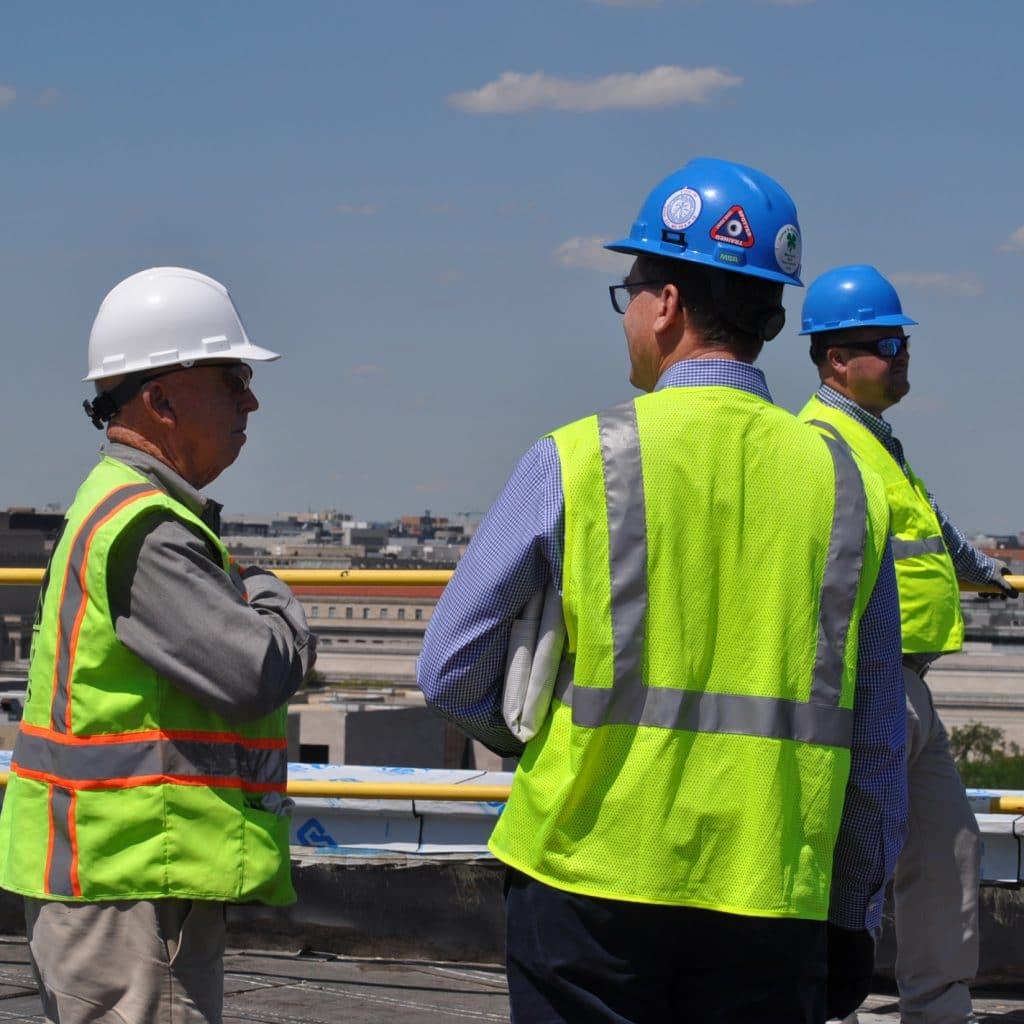
By Mark Gruenberg and John Wojcik
Press Associates Union News Service
The U.S. needs to spend $4 trillion, four times as much as the Republican Trump administration requested, for needed infrastructure repairs, the president of North America’s Building Trades Unions says.
And that’s what the unions will lobby for, adds NABTU President Sean McGarvey. And there must be “a dedicated funding source,” including an increased federal gasoline tax, to provide the money, he contends. Another large chunk of change, he said, will come from public-private partnerships.
McGarvey and construction union presidents James Callahan of the Operating Engineers, Robert Martinez of the Machinists and Lonnie Stephenson of the Electrical Workers made the case for more money at an October 23 press conference during the AFL-CIO Convention in St. Louis.
Despite the recovery from the Great Recession, which didn’t start in the construction industry until 2011, the U.S. still has great unmet infrastructure needs, the four said. They include old water pipes, underground utilities which break down, cracking and decaying roads and a creaky electrical grid.
“We’re also concerned about the funding, but also with the underground subsystems,” Callahan said. They’re “the sewers, the electrical lines and what’s below the roads. That’s why we’re trying to get a permanent (fiscal) ‘lockbox,’ both for funding structures and for hiring enough people.”
Repairing all that via a federal infrastructure law would put and keep even more construction workers on the job, especially in coming colder months when residential construction slows, the four said.
That’s a distinct change, McGarvey and the others admitted, from the depths of the Great Recession, which began when the bottom dropped out of the housing market. Construction joblessness hit a high of 2.44 million in February 2010, and the construction jobless rate that month was 27.1 percent. The September 2017 data, the latest available, show 433,000 jobless construction workers (4.7 percent).
The Trump administration has yet to produce a detailed infrastructure plan, though congressional committees have held hearings on the nation’s needs. And McGarvey said his department has been working with both the White House and three business groups – the Business Roundtable, the National Association of Manufacturers and the Chamber of Commerce – on crafting legislation.
The Chamber traditionally allied with the construction unions in pushing for infrastructure spending.
But the administration also floated the idea of funding all infrastructure improvements at the $1 trillion level and only through the partnerships, rather than direct federal spending. That’s produced criticism the money would flow into Wall Streeters’ pockets rather than rebuilding the country.
McGarvey floated a third idea for funding infrastructure repairs: Using negotiations on the pending tax bill, which analysts call a tax cut for the rich, to produce “a huge repatriation payment” of corporate profits now stashed overseas to escape U.S. taxes. “We also haven’t had a gas tax increase in 25 years.”
The type of funding and its sources will help the building trades unions evaluate it, he said. And he said that, despite appearances, both the administration and Senate Minority Leader Chuck Schumer, D-N.Y., are fully engaged on the infrastructure issue.
That assessment appears to differ somewhat from remarks by AFL-CIO President Richard Trumka a day earlier. Trumka said infrastructure is one of the area where Trump has so far produced “nothing.”
There’s another reason the construction unions push infrastructure spending, the four presidents said: Apprenticeships. They pointed out training new apprentices is absolutely needed not just to build the projects but to replace the tens of thousands of Baby Boomer construction workers who retire every year.
At the same time, apprenticeships are also vital to increasing participation by women, minorities and veterans in construction, which is still a white male-dominated field. Federal data show 3 percent of construction workers are women, 6.8 percent are African-American, 1.7 percent are Asian-American and 34 percent are Latino.
That led McGarvey and several other construction union leaders to join a Trump administration advisory task force on increasing apprenticeships. “The administration views” union apprenticeship programs “as a model” for the industry, McGarvey claimed. Though he did not say so, the administration also proposed a budget cut in federal apprenticeship aid.
McGarvey said in an interview last spring that raising the issue of the need for apprentices, especially for women and minorities, was one reason he and other construction union leaders engaged with Trump so early on, despite criticism from others in the labor movement for doing so.
But even more apprentices won’t fill the workplace void, the union presidents said. That will occur only when construction firms, notably non-union firms, pay their workers what they’re worth. A pay rate of $15 an hour, for a worker with a family of four or “women of color with kids” is not enough, McGarvey and Stephenson said. “As long as these companies go higher” than that, “we can get them the workforce. What we don’t have a guarantee on is jobs. And we’ve got to make sure our contractors are competitive.”
Related News
- FRA Issues Grade-Crossing Safety Advisory
- Amtrak To Give SMART-TD Members Holiday Bonuses
- Federal judge orders release of Kilmar Abrego Garcia from immigration detention — General President Coleman responds
- SEPTA Strike Avoided: Strong Agreement Secured
- DC attorney general secures $1.5 million from construction company for wage theft, worker misclassification
- Posthumous Retirement Ceremony Honors Lost Brother
- SMART-TD: Built by Members, Driven by Your Voice
- Conductor, Volunteer Firefighter Injured and Needs our Help
- Local 85 members organize 5K to address mental health, suicide in the construction industry
- FRA Doubles Our Risk By Reducing Track Inspections